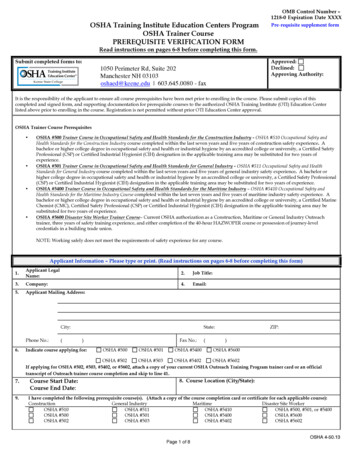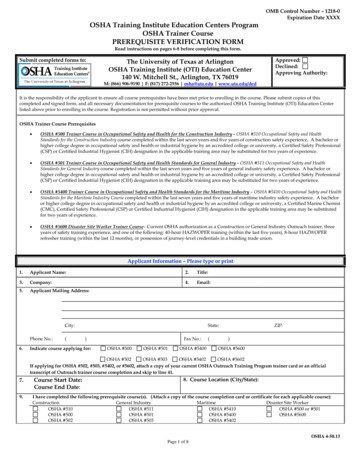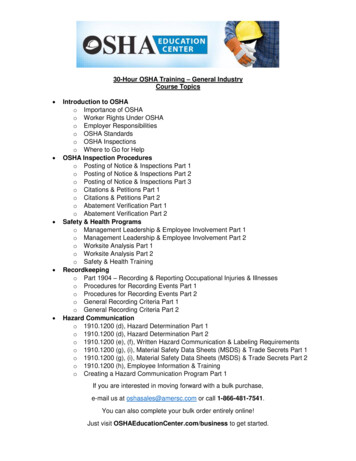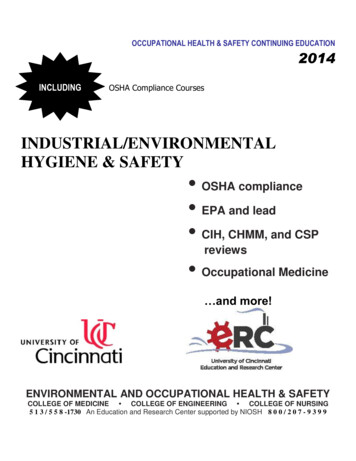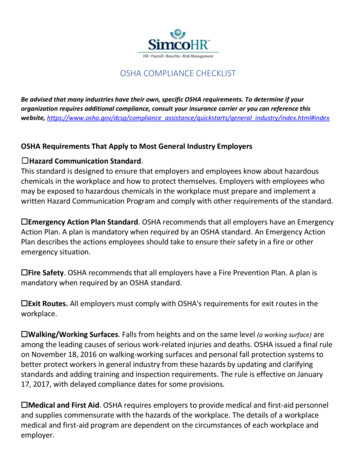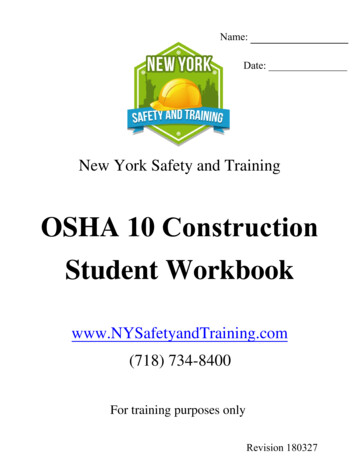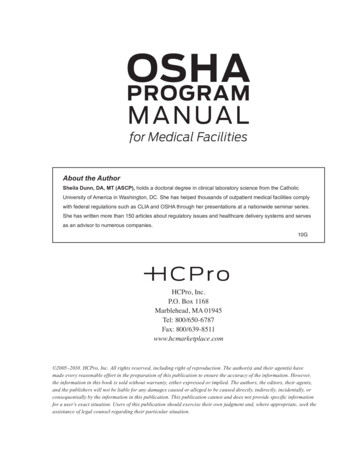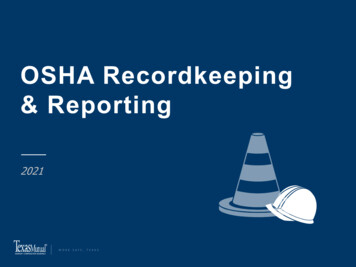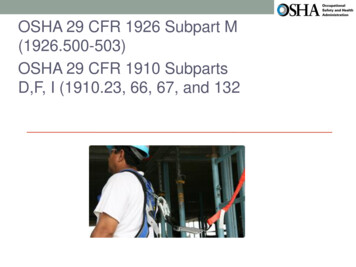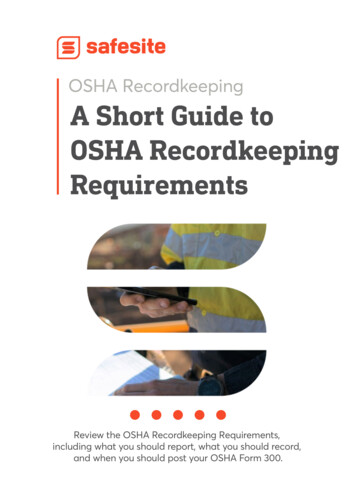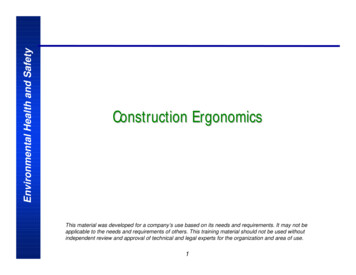
Transcription
Environmental Health and SafetyConstruction ErgonomicsThis material was developed for a company’s use based on its needs and requirements. It may not beapplicable to the needs and requirements of others. This training material should not be used withoutindependent review and approval of technical and legal experts for the organization and area of use.1
Environmental Health and SafetyOutline Review Basic Ergonomics Principles What is ergonomics?Types of ergonomic injuriesImportance of early reportingStretching basics Ergonomic risk factors present in construction Ergonomics tips to minimize risk factor exposure Summary2
Environmental Health and SafetyWhat is Ergonomics? Ergonomics (er'gõ nom'iks): The study of work and the relationship of work tothe physical and cognitive capabilities of peopleFitting the job (tools, tasks, and environment) tothe employee, instead of forcing the worker to fitthe job Ergonomic principles derived from manyareas, including: BiomechanicsPhysiologyAnthropometryIndustrial engineeringSafety3
Environmental Health and SafetyErgonomic Injuries Two classifications of ergonomic injuries Cumulative Trauma Disorders (CTD’s) – exposure driven Strains/Sprains – instantaneous (event driven)4
Environmental Health and SafetyErgonomic Injuries Cumulative Trauma Disorders (CTD’s) Injury to soft tissue caused by prolonged exposure to multipleergonomic risk factors Typically develop in small body segments (i.e. fingers, wrists,elbows, and neck) Examples of CTD’s Tendon disorders:––Inflammation of tendon and/or tendon sheathing caused by repeatedrubbing against ligaments, bone, etc.Lateral epicondylitis (tennis elbow) Nerve disorders:––Compression of nerves from repeated or sustained exposure to sharpedges, bones, ligaments, and/or tendonsCarpal tunnel syndrome Neurovascular disorders:––Compression of blood vessels and/or nerves from repeated exposureto vibration or cold temperaturesRaynaud’s phenomenon (white finger syndrome)5
Environmental Health and SafetyErgonomic Injuries Strains & Sprains Injury to connective tissue caused by singleforceful event: lifting heavy objects in awkwardposition Common to large body segments (i.e. back,legs, and shoulders) Risk of injury increases with the presence ofmultiple risk factors6
Environmental Health and SafetyEarly Reporting of Ergonomic Issues Proactive Reporting: Report suspected ergonomics risk factorsto your supervisor and safetycommittee representative Early Reporting Process: Report pain or discomfort associated withwork to your supervisor and OccupationalHealth Services Benefits to Early Reporting: Leads to early care and quicker healing,preventing chronic problems Leads to quicker identification of the rootcause of the injury Will initiate an ergonomics evaluation bytrained personnel7
Environmental Health and SafetyStretching Basics Benefits of stretching: Increases flexibility/elasticity ofmuscles Increases circulation to warm themuscles, improving mental alertness,reducing fatigue Decreases muscle tension and stress When to Stretch: Prior to starting your day During short breaks (at least once perhour) After breaks or lunch to prevent fatigue If tension or stress is apparent After a lengthy task duration or anextended awkward posture8
Environmental Health and SafetyStretching Basics Proper stretching techniques: Relax and breathe normally. Do nothold your breath. Hold each stretch for a count of 15, oras long as comfort is maintained. Use gentle, controlled motions. Do notbounce! Keep the knees slightly bent for betterbalance. Stretch until a mild tension is felt, thenrelax. Stretch by how you feel and not byhow far you can go.9
Static LoadingRepetitionCoSt ntare ctssEnvironmental Health and SafetyErgonomic Risk FactorsForceAwkwardPostureVibrationRisk of injury increases with: Prolonged exposure to any of these ergonomic risk factors Presence of multiple risk factors within a single job task10
Environmental Health and SafetyErgonomic Tips to Minimize Awkward Postures Work near elbow height to avoidbending excessive bending Avoid overhead reaching andkneeling when possible11
Environmental Health and SafetyErgonomic Tips to Minimize Awkward Postures Where awkward postures areunavoidable, change tasks, stretch,and take short breaks frequently12
Environmental Health and SafetyErgonomic Tips to Minimize Awkward Postures Select the correct tool handle orientation based uponworksurface height/orientation (when possible)In-line gripPistol gripPrimary UseSurface OrientationSelect this tool typeAbove shoulderheightvertical surfacein-line griphorizontal surfacepistol gripvertical surfacepistol griphorizontal surfacein-line gripvertical surfacein-line griphorizontal surfacepistol gripBetween elbow andshoulder heightBelow elbow height13
Environmental Health and SafetyErgonomic Tips to Minimize Force Use mechanical lift assists andcarts when available Avoid manually handling heavyobjects (more than 35 pounds) Avoid carrying objects more than 100feet Practice Proper Cart Handling Push instead of pulling Use both hands when pushing Stand directly behind the cart whenpushing (avoid twisting your body) Maintain good control and limit speed Ensure cart is not overloaded14
Environmental Health and SafetyErgonomic Tips to Minimize Force Use proper lifting techniques whenlifting Examine the load and the surroundingarea Bend knees when lifting a load Look forward to keep back straight Position the load close to the body Maintain a firm grip on the load Use smooth, controlled movements Keep arms in front of body Turn feet in direction of movement toavoid twisting Get help before performingtasks requiring excessiveforce15
Environmental Health and SafetyErgonomic Tips to Minimize ForceA Two-Person Lift Is Appropriate When. . . A lift, hoist or other mechanicalassistance is unavailable The object is heavier than you arecapable of lifting alone (typically morethan 35 pounds) The object is not heavier than whattwo people are capable of lifting(typically less than 60 pounds) The object is awkward or oversized. Any object that does not have itsweight equally distributed within theload. Remember some objects are tooheavy or awkward to be handledwith two people16
Environmental Health and SafetyErgonomic Tips to Minimize Force Use the correct tools / poweredtools for the task Powered tools tend to require lessexertion to perform a task Ensure that the weight of a poweredtool (and cording) does not createadditional force issues Use only the amount of forcenecessary to complete the task17
Environmental Health and SafetyErgonomic Tips to Minimize Repetition Repetition: Use power tools when available Change tasks, stretch, or take abreak from repetitive tasks Follow job rotation policies whereapplicable – effective job rotationswork alternate muscle groupsbetween successive job functions18
Environmental Health and SafetyErgonomic Tips to Minimize Static Loading Static Loading: Avoid prolonged awkward postures Change the position of the work oryour body position to get as close aspossible to the work area If prolonged awkward postures areunavoidable, use a “supported”posture to compensate A supported posture uses part ofyour body to support the weight ofanother body segment that is in anawkward position19
Environmental Health and SafetyErgonomic Tips to Minimize Contact Stress Select hand tools that conforms to thegeometry of the hands Pistol grip & in-line tools: Recommended handle length: 5.0inches Recommended handle diameter: 1.0 to1.5 inches Pliers & crimping action tools: Recommended handle length: 4.0inches (minimum) Recommended handle span: 2.5inches Avoid handles that end in the palmof the hand204.0 inches
Environmental Health and SafetyErgonomic Tips to Minimize Contact Stress Avoid pressure on palms, wrists,and elbows: Use padding on hard or sharp surfaces Change your position to eliminate thestress Avoid pressure on knees: Avoid kneeling on hard surfaces forprolonged periods Use knee pads when kneeling tasksare unavoidable21
Environmental Health and SafetyErgonomic Tips to Minimize Vibration & Torque To lessen vibration: Pad tool handles with a soft compressiblesurfaceUse vibration damping (gel filled) glovesSelect tools (hammers and chippers) withbuilt in damping systems(springs/hydraulics) To lessen torque reaction: Use electric tools as opposed to air driventoolsUse pulse tools or auto-shutoff tools22
Environmental Health and SafetySummary Minimize ergonomic risk factors in your area Stretch throughout the shift especially before and afteractivities that require awkward positions or lifting Pay attention to your body and know your physicallimitations Report ergonomics issues through appropriate channels. Ergonomic injuries are preventable, and you own your ownsafety23
Ergonomic Tips to Minimize Force Use the correct tools / powered tools for the task Powered tools tend to require less exertion to perform a task Ensure that the weight of a powered tool (and cording) does not create additional force issues Use only the amount of force necessary to complete the task
